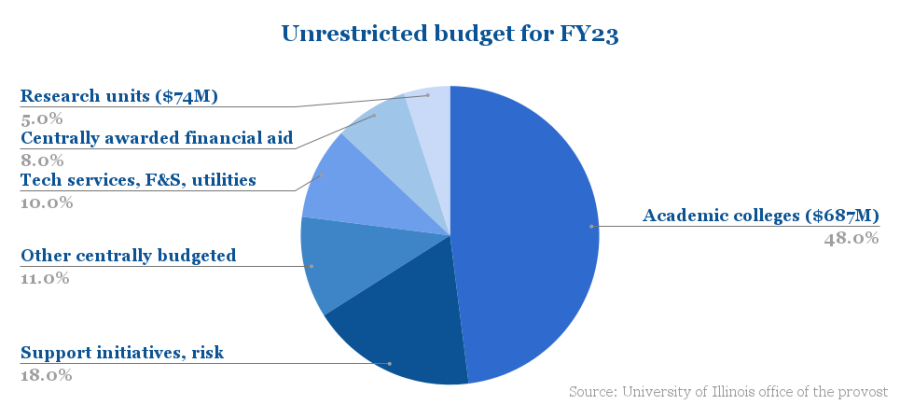Unrestricted budget
Jun 30, 2023
Last updated on July 8, 2023 at 01:55 a.m.
As illustrated by figures from the office of the provost, the largest portion of the University’s unrestricted budget for this fiscal year went back to academic colleges. Gress said the vast majority of this allocation went toward salaries for faculty.
Portions of the unrestricted budget also went to fund centrally awarded financial aid, technology services, Facilities & Services, utilities, campus-wide support initiatives, insurance for the University’s campus, other centrally budgeted administration costs and campus-level research units such as the Carl R. Woese Institute for Genomic Biology and the Beckman Institute.
Gress said the tuition dollars that students are charged by the University will work to support their education. This includes the out-of-state premium charges and additional funds charged by certain programs.
“The differential that nonresidents pay, we take 20% of that and flow it to the college of enrollment, but then the other 80% gets put into the (tuition) bucket with the base rate,” Gress said. “Some of the colleges have program differentials, like engineering or business — and some others across the campus. Those were requested and approved because they could make a case that it costs them more to deliver their education in those programs.”
Get The Daily Illini in your inbox!
Differential funding charged by certain colleges or programs flows directly to those entities and does not apply to the University’s budget, Gress said.
As the University’s tuition revenue has grown, Gress said that the central investment in financial aid has grown with it. She went on to say that the University projects smaller increases in financial aid spending over the next several years.
“The Illinois Commitment scholarship, which is the one where families under a base salary or income level get full tuition and fee funding for four years, started in 2020,” Gress said. “As we brought each cohort in, once the student receives the funding, they keep it the full four years. Now, there are four cohorts — freshman through senior. We’re projecting a leveling off (in financial aid costs) because … now it’s going to be four full classes that are receiving the funding.”
The Illinois Commitment scholarship is the University’s largest and most costly financial aid program.
Illinois Commitment provides full tuition and fee funding for in-state students whose family income totals less than $67,100 per year. Its introduction in 2020 contributed to a significant increase in financial aid costs for the University.
Gress indicated that there is no way to determine exactly where each base tuition dollar will go, but that the unrestricted budget figures could yield a close estimate.
“Tuition money is always going to be spent in support of the student’s education,” Gress said. “If you think about the provost’s office and the chancellor’s office and what we do, it’s really to support the education of the student. Students should rest assured that their money is going to be utilized in support of them.”

